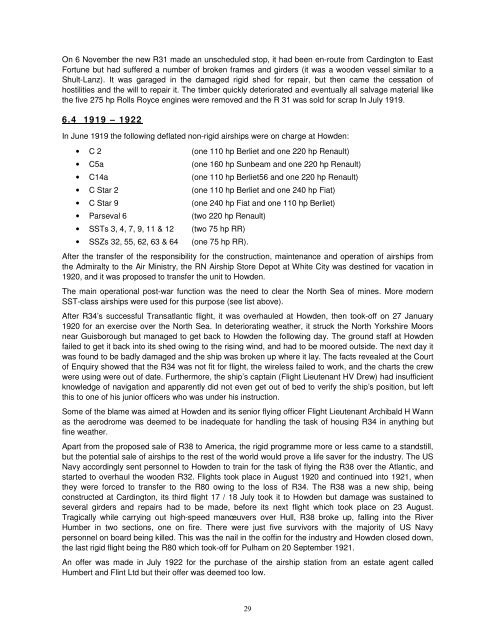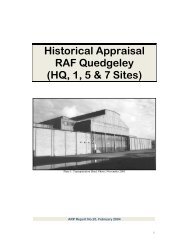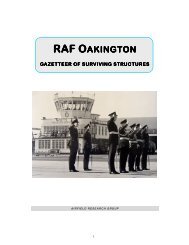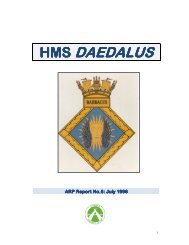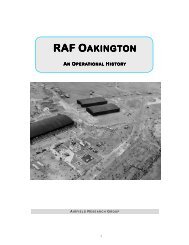RNAS Howden - The Airfield Research Group
RNAS Howden - The Airfield Research Group
RNAS Howden - The Airfield Research Group
You also want an ePaper? Increase the reach of your titles
YUMPU automatically turns print PDFs into web optimized ePapers that Google loves.
On 6 November the new R31 made an unscheduled stop, it had been en-route from Cardington to East<br />
Fortune but had suffered a number of broken frames and girders (it was a wooden vessel similar to a<br />
Shult-Lanz). It was garaged in the damaged rigid shed for repair, but then came the cessation of<br />
hostilities and the will to repair it. <strong>The</strong> timber quickly deteriorated and eventually all salvage material like<br />
the five 275 hp Rolls Royce engines were removed and the R 31 was sold for scrap In July 1919.<br />
6.4 1919 – 1922<br />
In June 1919 the following deflated non-rigid airships were on charge at <strong>Howden</strong>:<br />
• C 2 (one 110 hp Berliet and one 220 hp Renault)<br />
• C5a (one 160 hp Sunbeam and one 220 hp Renault)<br />
• C14a (one 110 hp Berliet56 and one 220 hp Renault)<br />
• C Star 2 (one 110 hp Berliet and one 240 hp Fiat)<br />
• C Star 9 (one 240 hp Fiat and one 110 hp Berliet)<br />
• Parseval 6 (two 220 hp Renault)<br />
• SSTs 3, 4, 7, 9, 11 & 12 (two 75 hp RR)<br />
• SSZs 32, 55, 62, 63 & 64 (one 75 hp RR).<br />
After the transfer of the responsibility for the construction, maintenance and operation of airships from<br />
the Admiralty to the Air Ministry, the RN Airship Store Depot at White City was destined for vacation in<br />
1920, and it was proposed to transfer the unit to <strong>Howden</strong>.<br />
<strong>The</strong> main operational post-war function was the need to clear the North Sea of mines. More modern<br />
SST-class airships were used for this purpose (see list above).<br />
After R34’s successful Transatlantic flight, it was overhauled at <strong>Howden</strong>, then took-off on 27 January<br />
1920 for an exercise over the North Sea. In deteriorating weather, it struck the North Yorkshire Moors<br />
near Guisborough but managed to get back to <strong>Howden</strong> the following day. <strong>The</strong> ground staff at <strong>Howden</strong><br />
failed to get it back into its shed owing to the rising wind, and had to be moored outside. <strong>The</strong> next day it<br />
was found to be badly damaged and the ship was broken up where it lay. <strong>The</strong> facts revealed at the Court<br />
of Enquiry showed that the R34 was not fit for flight, the wireless failed to work, and the charts the crew<br />
were using were out of date. Furthermore, the ship’s captain (Flight Lieutenant HV Drew) had insufficient<br />
knowledge of navigation and apparently did not even get out of bed to verify the ship’s position, but left<br />
this to one of his junior officers who was under his instruction.<br />
Some of the blame was aimed at <strong>Howden</strong> and its senior flying officer Flight Lieutenant Archibald H Wann<br />
as the aerodrome was deemed to be inadequate for handling the task of housing R34 in anything but<br />
fine weather.<br />
Apart from the proposed sale of R38 to America, the rigid programme more or less came to a standstill,<br />
but the potential sale of airships to the rest of the world would prove a life saver for the industry. <strong>The</strong> US<br />
Navy accordingly sent personnel to <strong>Howden</strong> to train for the task of flying the R38 over the Atlantic, and<br />
started to overhaul the wooden R32. Flights took place in August 1920 and continued into 1921, when<br />
they were forced to transfer to the R80 owing to the loss of R34. <strong>The</strong> R38 was a new ship, being<br />
constructed at Cardington, its third flight 17 / 18 July took it to <strong>Howden</strong> but damage was sustained to<br />
several girders and repairs had to be made, before its next flight which took place on 23 August.<br />
Tragically while carrying out high-speed manœuvers over Hull, R38 broke up, falling into the River<br />
Humber in two sections, one on fire. <strong>The</strong>re were just five survivors with the majority of US Navy<br />
personnel on board being killed. This was the nail in the coffin for the industry and <strong>Howden</strong> closed down,<br />
the last rigid flight being the R80 which took-off for Pulham on 20 September 1921.<br />
An offer was made in July 1922 for the purchase of the airship station from an estate agent called<br />
Humbert and Flint Ltd but their offer was deemed too low.<br />
29


